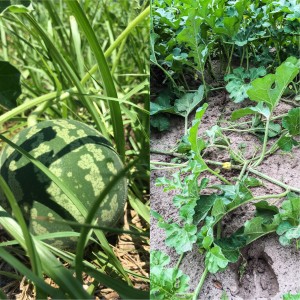This time of year we often encounter citron melons in our crops and gardens. A citron is sometimes referred to as a stock melon or a preserving melon. The citron melon belongs to the same species as watermelon, but the fruit is inedible in the raw state. It should not be confused with the citron of the citrus fruit family.
Volunteer citron melons are commonly found scattered around old fields, orange groves, and roadsides throughout Florida. Locally, we often see seeds spread though cattle manure from local livestock markets. Although an excellent source of fertilizer, it can introduce nuisance weeds to small gardens. If allowed to grow freely, this melon can become a nuisance. The vines can spread rapidly and cover large distances, choking out desired plants.
Postemergence applications of Cadre and 2,4-DB provide good control of citron melons in peanuts. Postemergence applications of glyphosate or Staple will give good to excellent control in cotton, but a tank-mix of glyphosate + Staple will consistently be the most effective treatment. Likewise, post directed applications that contain glyphosate are effective control programs.
Source: Citron (Citron Melon), Citrullus lanatus (Thunb.) Mats. & Nakai By: David W. Hall, Vernon V. Vandiver, and Jason A. Ferrell
Written and Posted by Sarah Chambers, Extension intern

